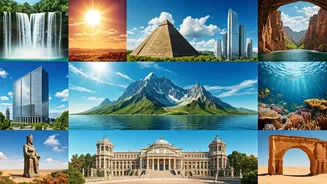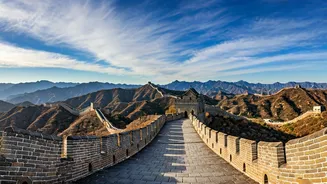Great Wall of China
Stretching over 13,000 miles, the Great Wall of China is a testament to human ingenuity and perseverance. Constructed over centuries, this monumental fortification
served as a defense against invaders. Walking along the wall, you can witness the breathtaking views of the Chinese landscape and reflect on its historical significance. The wall's imposing presence and intricate design provide a deep understanding of ancient China's military might and architectural prowess. This marvel stands as a symbol of unity, strength, and the enduring spirit of the Chinese people, inviting visitors to journey through time and explore a legacy of unparalleled grandeur. The Great Wall stands as a truly awe-inspiring sight that continues to captivate the world.
Petra, Jordan's Gem
Carved into sandstone cliffs, Petra, the 'Lost City', reveals the architectural achievements of the Nabataean civilization. The Treasury, with its intricate facade, is the most iconic structure. As you walk through the Siq, a narrow gorge leading to Petra, the anticipation builds. Petra thrived as a trading hub, with elaborate tombs, temples, and residential areas. The city's sophisticated water systems and stunning rock-cut architecture showcases the Nabataeans' mastery. Exploring Petra gives you a chance to immerse yourself in history and the beauty of a bygone era. The stunning rock-cut facades and complex engineering stand as a testament to the Nabataeans' advanced civilization. This historical site offers an enriching experience that will stay with you long after your visit.
The Colosseum, Rome
The Colosseum in Rome, a vast amphitheater, stands as a reminder of the Roman Empire's power and entertainment. Built to host gladiatorial contests and public spectacles, it is an engineering marvel. It could hold over 50,000 spectators and the intricate design and construction techniques showcase Roman architectural expertise. Walking through the Colosseum, you can feel the echoes of history, from the roaring crowds to the clash of gladiators. Exploring the remains gives insights into Roman society, politics, and the daily lives of the people. The grandeur of the Colosseum demonstrates the lasting impact of the Roman Empire and remains a must-see destination for history buffs and travelers alike. Its strategic positioning, sophisticated systems, and historical significance highlight the legacy of Roman engineering and culture.
Machu Picchu, Peru
Perched high in the Andes Mountains, Machu Picchu is an ancient Inca city. The city is a masterpiece of architectural skill and design. It was a royal estate and ceremonial center, hidden from the world until its rediscovery in 1911. The intricate stonework, precisely fitted without mortar, testifies to the Inca's advanced engineering. The city's location in a dramatic landscape provides breathtaking views of the surrounding mountains and valleys. Visiting Machu Picchu offers a chance to explore a unique civilization and experience the mystery and wonder of the Inca Empire. It shows the incredible ingenuity of the Inca people, the stunning beauty of the landscape and the mysteries still to be uncovered.
Chichen Itza, Mexico
Chichen Itza in the Yucatán Peninsula of Mexico, is a complex of ancient Mayan structures, demonstrating the Mayan civilization's astronomical knowledge and architectural talent. The most famous structure, El Castillo, is a step pyramid with precise astronomical alignments. The site reveals the Mayans' mastery of mathematics, engineering, and astronomy. Exploring Chichen Itza is like traveling back in time to discover the intricacies of Mayan culture. This cultural site showcases the complex society, belief systems, and scientific achievements of the Mayans. Its strategic location and historical importance make it a significant destination for anyone looking to learn about ancient civilizations. The meticulous planning, along with the precise alignment of buildings, displays the advanced understanding of the Mayan society.
Taj Mahal, India
The Taj Mahal in Agra, India, is a monument to love, commissioned by Mughal emperor Shah Jahan for his wife Mumtaz Mahal. The marble mausoleum is renowned for its architectural beauty and intricate details. Every element, from the symmetry to the delicate inlays, reflects an unwavering devotion. The construction, which took over 20 years, involved skilled artisans. The Taj Mahal is a tribute to Mughal art and culture. It draws millions of visitors to witness its romantic story and stunning design. It is a symbol of love and a lasting legacy of the Mughal Empire. The reflection in the surrounding pools and the play of light create a magical atmosphere, making it a truly mesmerizing experience.
Christ the Redeemer, Brazil
Perched atop Mount Corcovado in Rio de Janeiro, Brazil, Christ the Redeemer is a towering statue. The statue, with its outstretched arms, offers panoramic views of the city. It is a symbol of faith and a landmark in itself. The Art Deco statue, designed by Heitor da Silva Costa and sculpted by Paul Landowski, symbolizes the welcoming spirit of the Brazilian people. Visiting Christ the Redeemer is a moving experience. It is a place of peace, reflection, and appreciation. The stunning views of Rio de Janeiro, with the iconic beaches, mountains, and the vibrant city below, make it one of the most visited sites in the world. The design and the positioning show its cultural and spiritual relevance.
The Pyramids, Giza
The Great Pyramids of Giza, near Cairo, Egypt, are ancient wonders and the last surviving ones of the original Seven Wonders of the Ancient World. Built as tombs for pharaohs, the pyramids exemplify ancient Egyptian architectural and engineering mastery. The largest, the Great Pyramid of Khufu, is a massive structure made of millions of stone blocks. Exploring the pyramids and the Sphinx offers a chance to understand the religious beliefs, the advanced engineering, and the history of ancient Egypt. The precision of the construction and their monumental size still amaze and inspire. This site reveals the ancient Egyptians' complex religious beliefs, the advanced engineering skills, and a glimpse into their civilization. It stands as a testament to the ingenuity and power of the pharaohs.
Eiffel Tower, France
The Eiffel Tower in Paris, a wrought-iron lattice tower, is one of the world's most recognizable structures. Constructed for the 1889 World's Fair, it was initially criticized but later became a symbol of the city and of France. The tower offers stunning views of Paris, including the Champs-Élysées and the Louvre. Climbing to the top or enjoying a meal at one of the restaurants offers a unique perspective of the city. The Eiffel Tower's design, engineering, and cultural significance have made it a global icon and a symbol of modernity. Today, it stands as a symbol of Parisian charm, attracting millions of visitors and inspiring artists and dreamers alike. The architecture and its position in the Parisian skyline have made it a symbol of romance, culture, and innovation.











